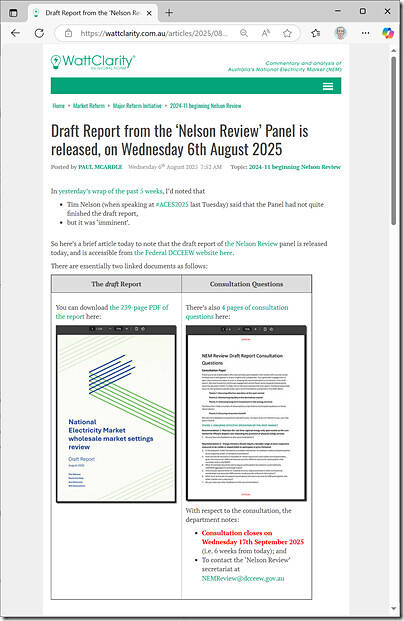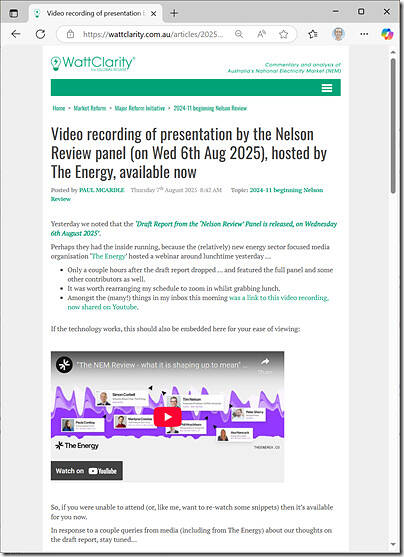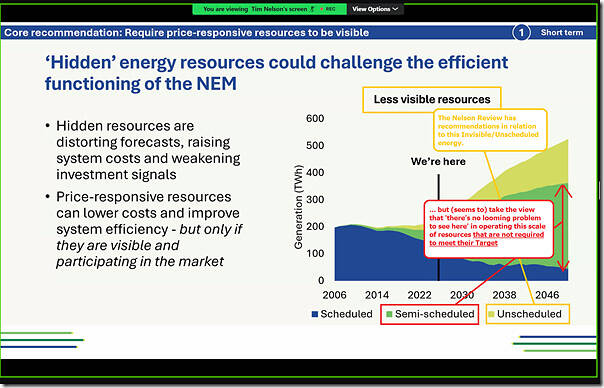As noted here earlier, I’ve been away for over a month, so am grappling with an overflowing ‘to do’ list upon my return:
- Not just in terms of what’s happening within Global-Roam Pty Ltd (where I work, and the producers of WattClarity)
- But also in the other companies we have shareholdings with (Overwatch Energy and ETSI) are also in favourable positions seeing bursts of activity into which I’m trying to add value.
With that in mind:
- I’ll apologise that some readers might see this article is really only a teaser into which more thinking (and hopefully insight) might be added over the next couple months.
- Also noting that some frequent readers will also recognise that the article title is really just a different way of asking the question we’ve been asking for a number of years now, such as in GenInsights21 Observation 13 … ‘is the Semi-Scheduled category sustainable or scalable?’.
From the Nelson Review
But a couple things happened in relation to the Nelson Review yesterday that flowed on from other recent conversations and made me wonder if the question should be be reframed to help focus the analysis:
1) Firstly, we noted yesterday that the draft report from the Nelson Review (which had been ‘imminent’ last week at #ACES2025) had been released:
2) This was quickly followed up with a lunchtime webinar hosted by The Energy (and featuring all four panel members) walking through the report – with the recording of the webinar now available on YouTube, thanks to The Energy:
(One of) the Questions we have
Much of the focus of the Nelson Review revolves around incentivising developers to build what the AEMO says (via the ISP) will be required in terms of VRE + Firming out till 2050.
My transcription of what Tim Nelson says at about 08:30…
‘A reminder of what our scope looks like … the terms of reference for the review really goes to the heart of what comes after the Capacity Investment Scheme for driving investment in firmed renewables’
… which helps explain some of the outcomes in the draft report.
We’ll come back to that in a later article, but I wanted in this article to highlight a slide that I captured later in the presentation (at about 15:40) and have annotated with two comments:
The trend chart there is a projection that the Panel has just lifted out of the ISP* and …
* we won’t go down a rabbit hole here about how likely it is that this is where we’ll end up, and what other alternate scenarios might unfold instead …
1) it was used to illustrate the Panel’s recommendations about invisible (price responsive) resources that will prove a increasing challenge to the future operation of the NEM:
(a) Tim’s comments are about the efficient operation of the NEM
(b) But I’ve wondered (and written before) about potential challenges at certain seasons and times of day of even keeping the grid stable, depending on other factors.
2) However, my point in highlighting this slide is to emphasise that the much larger wad of VRE energy that’s labelled Semi-Scheduled seems to be assumed (by the Panel) to present no real problem at all, even out in 2050 where readers can see it’s many multiples larger than the share of energy that is full Scheduled:
(a) My spidey senses have been tingling for some years to give me concerns that we’re potentially missing something really big here.
(b) Now, for those at the loopy left or the rabid right of the Emotion-o-meter let me be clear that:
i. I’m not specifically talking here about the fact that these resources are VRE;
ii. In this case, I’m speaking about the manner in which we enable them to operate in the NEM, in which Targets are not really that – which we’ve means that there are increasing levels of overs-and-unders that need to be made up by Scheduled resources (especially those providing frequency control via Regulation FCAS).
Analysis completed to date
Briefly …
What’s the (potential) growing problem?
Through the GRC2018 and then into GenInsights21 and into GenInsights Quarterly Updates and via articles on WattClarity we have been exploring this question for some time – looking in particular at:
1) a measure of ‘Aggregate Raw Off-Target’ as a collective measure of the underperformance or overperformance of Semi-Scheduled units
… in particular you might like to review articles collated under ‘Trend of AggROT (across Semi-Scheduled units)’ to see how this has been trending over time.
2) there’s also a growing number of articles tagged with ‘frequency disruption’:
(a) Whilst historically most of these have been as a result of large unit trips or network disruptions (or frequency spikes on occasion of trips of load)
(b) We’re starting to see a different pattern of disruption emerge as a result of collective VRE underperformance.
Mixed messages for Semi-Scheduled units?
Worth noting for readers that the Semi-Scheduled units seem to (in my view) face mixed messages:
The Main Message) from a dispatch point of view (and even after there was some tightening of requirements in 2021) the UIGF and hence the Target seems:
(a) Only loosely relevant during Semi-Dispatch Cap periods as a ‘cap’, not as a target that actually needs to be met;
(b) Whilst during non-SDC periods even less so.
… is it any wonder that they’ve learnt to fly gliders and not fully controllable planes?
Contrary Message) in contrast, through the relatively new Frequency Performance Payments (FPP) mechanism**, there is some financial incentive for Semi-Scheduled units:
** remembering that, under FPP, there’s a two-way incentive for PFR, and also cost recovery for Regulation FCAS.
(a) to improve their UIGF (and hopefully abandon any ‘games that self-forecasters can play’)
(b) and actually follow their target in a straight line trajectory.
… but is that enough?
The view of others?
My sense is that (apart from a growing number of others) many in the industry (and potentially on the Panel at this point) seem to be placing their hope in:
1) That Primary Frequency Response will ‘solve’ the growing problem;
2) With the addition of escalating requirement for enablement of Regulation FCAS.
… but is that enough, we ask?
What might help to solve the problem?
Certainly, better forecasts for UIGF will be a big step forwards (that’s why we invested in ETSI, to help raise the bar).
1) But we wonder if even that will be enough … do we need to restrict/cap, or sunset, or restrict new entry to the Semi-Scheduled category?)
2) If this were to happen, then at least all new Solar and Wind units might need to register as fully Scheduled hybrids … and so actually help with the unders and overs increasingly seen.
So we will look to continue and deepen this line of analysis in the coming weeks …
Deadlines
In order to give us some incentive to focus some more attention on this question in the coming weeks, I’m noting for myself two particular deadlines
- The industry has just under 6 weeks now (until Wednesday 17th September 2025) to make a submission on this Draft Report; and
- Additionally, I’ve been asked to speak at the up-coming ‘NEM dev 2025’ conference (a joint Academic + Industry conference in Brisbane on 7th and 8th October 2025), to wrap up with some thoughts about the NEM of the future, and thought it would be useful to explore this question (amongst other things) in my speaking slot.
Let’s see how we go in pursuing more analysis and pulling our thoughts together.





Suppose at Eraring we have an accident similar to what happened at Callide C4 in 2021. Do we really have the renewables and storage to replace this coal plant at full capacity? What would happen during a dark, cold winter week as just experienced end of July?
3 Aug 2025
Premier NSW energy guzzler in winter: coal plants running at 90 % capacity during critical evening periods
https://crudeoilpeak.info/premier-nsw-energy-guzzler-in-winter-coal-plants-running-at-90-capacity-during-critical-evening-periods
My website is on oil. But I got interested in power supplies because everyone assumes petrol and diesel cars can be easily replaced by EVs. (The real problem are actually our diesel trucks!)
Excellent non-biased discussion. Thanks Paul
Isn’t the question not whether the NEM can operate on 82% renewables by 2030 but whether ALL consumers, particularly the largest consumer group SMEs (now called Business Mass Market by AEMO), can afford their power bills from a NEM with 82% renewables. After all, if energy consumers can’t afford their power bills then the plan has failed the National Electricity Objective. SMEs don’t get government bailouts like large energy users (eg steelworks and smelters) and can’t even access hardship programs. Over 5 million Aussies depend on a small business (under 20 employees) to put food on the table and a roof over their heads. This is not just an engineering problem.
It shouldn’t be too difficult because the amount of grid electricity generated and sold keeps falling every year, so the 82% target becomes relatively easier to achieve as time progresses.
But don’t ask how the rising cost of grid maintenance gets paid…